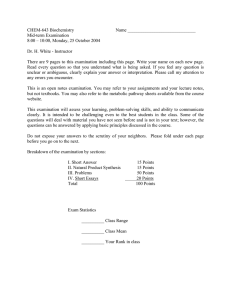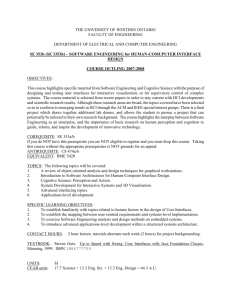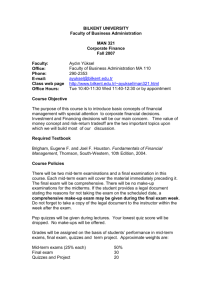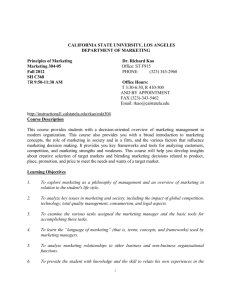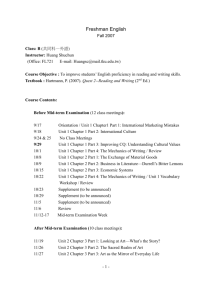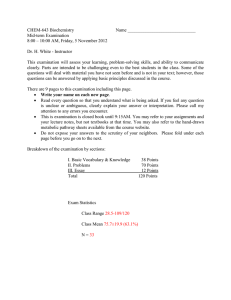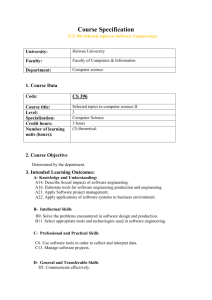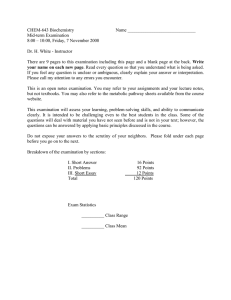CHEM-643 Biochemistry ... Mid-term Examination
advertisement
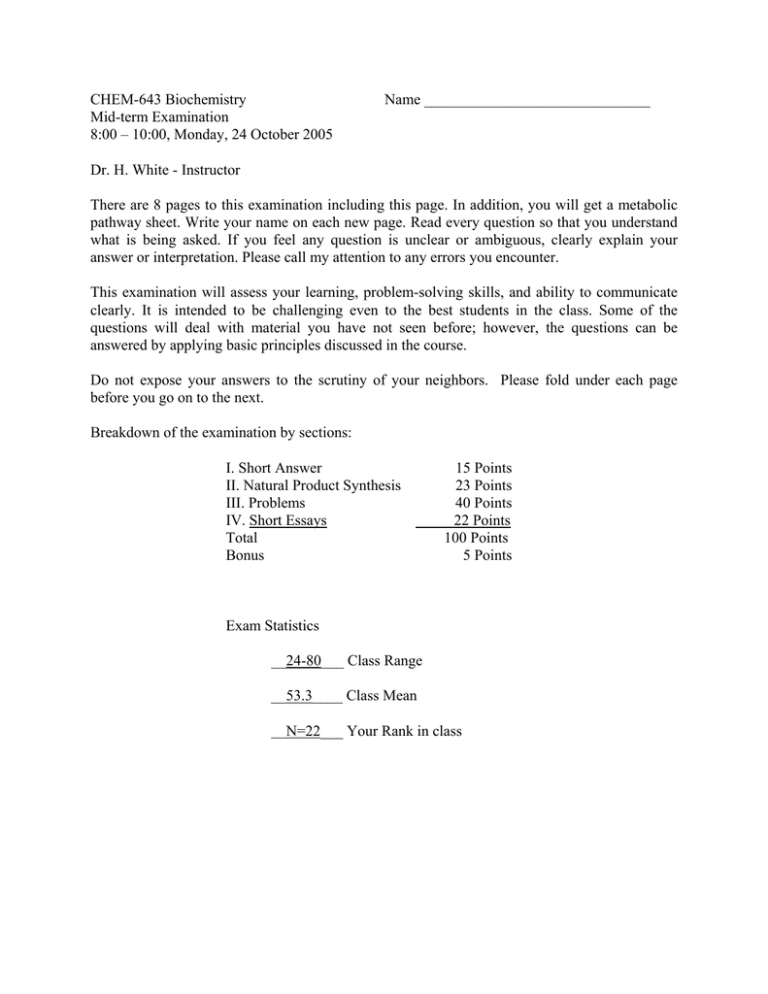
CHEM-643 Biochemistry Mid-term Examination 8:00 – 10:00, Monday, 24 October 2005 Name ______________________________ Dr. H. White - Instructor There are 8 pages to this examination including this page. In addition, you will get a metabolic pathway sheet. Write your name on each new page. Read every question so that you understand what is being asked. If you feel any question is unclear or ambiguous, clearly explain your answer or interpretation. Please call my attention to any errors you encounter. This examination will assess your learning, problem-solving skills, and ability to communicate clearly. It is intended to be challenging even to the best students in the class. Some of the questions will deal with material you have not seen before; however, the questions can be answered by applying basic principles discussed in the course. Do not expose your answers to the scrutiny of your neighbors. Please fold under each page before you go on to the next. Breakdown of the examination by sections: I. Short Answer II. Natural Product Synthesis III. Problems IV. Short Essays Total Bonus 15 Points 23 Points 40 Points 22 Points 100 Points 5 Points Exam Statistics __24-80___ Class Range __53.3____ Class Mean __N=22___ Your Rank in class CHEM-643 Intermediary Metabolism Mid-term Examination, 24 October 2005 Page 2 Name ______________________________ Part I - Short Answer Questions (1 point each) __________________________ 1. Number of phosphorus atoms in NADPH. __________________________ 2. Coenzyme associated with the decarboxylation of alpha keto acids. __________________________ 3. Coenzyme associated with the decarboxylation of alpha amino acids. __________________________ 4. Normal human blood glucose concentration. __________________________ 5. Transamination of pyruvate yields this compound. __________________________ 6. Reduction of pyruvate with NADH yields this compound. __________________________ 7. Disaccharide that causes problems for galactosemics. __________________________ 8. Leucine is to Valine as Lysine is to ________. __________________________ 9. Organ that exports ketone bodies. __________________________ 10. Type of cell in humans that lacks the TCA cycle. __________________________11. Major source of carbon for gluconeogenesis during starvation. __________________________ 12. Where in a cell would you find arachidonic acid? __________________________ 13. Highly regulated dodecameric enzyme. __________________________ 14. Number of electrons required to convert N2 to 2NH3 __________________________ 15. Group of organisms that can’t make steroids. CHEM-643 Intermediary Metabolism Mid-term Examination, 24 October 2005 Page 3 Name ______________________________ Part II Natural Product Biosynthesis: 1. (8 Points) β-Alanine, a precursor in the biosynthesis of the vitamin pantetheine, is boxed in the structure below. Propose a one step enzymatic synthesis of β-alanine from a common compound. [Alternatively, you can propose a one step enzymatic synthesis for cysteamine, another precursor, the part of pantetheine to the left of β-alanine below.] 2. (7 Points) Abscisic acid is a plant hormone that enables autumn leaves to separate and fall. Abscisic acid A. (2 Point) To what class of compounds does abscisic acid belong? B. (5 Points) In the space to the left of abscisic acid, draw the structure of a well-recognized, likely precursor in a way that shows their carbon-for-carbon relationship. CHEM-643 Intermediary Metabolism Mid-term Examination, 24 October 2005 Page 4 Name ______________________________ 3. (8 Points) Penicillin has the structure given below. Draw the structure of a dipeptide that serves as a biosynthetic precursors for its biosynthesis? (No carbon-carbon bonds are broken.) Identify the constitutent amino acids. Penicillin Part III Problems 4. (15 points) Using well-known enzyme reactions create a pathway that has the indicated over all stoichiometry. Draw the structures of all intermediates and indicate any cofactors. Aspartate + AcCoA + NAD+ + H2O → Glutamate + CO2 + CoASH + NADH + H+ CHEM-643 Intermediary Metabolism Mid-term Examination, 24 October 2005 Page 5 Name ______________________________ 5. (10 points) There are several ways to assay fatty acid synthase activity. One clever way measures the incorporation of radioactivity into fatty acids when using the labeled substrates, 14C-malonylCoA and 3H-acetylCoA. If the observed 14C/3H ratio in the product fatty acids indicated a 7.3/1 ratio of substrate incorporation (Malonyl CoA:Acetyl CoA), what products in what ratio would that suggest? (NADPH, but no ATP is added to the reaction mixture.) CHEM-643 Intermediary Metabolism Mid-term Examination, 24 October 2005 Page 6 Name ______________________________ 6. (15 Points) Consider the representation of a hypothetical branched biosynthetic pathway below in which precursor A is converted to end products E or H. a. (3 Points) Auxotrophic mutants were isolated which required E or H or both E and H for growth. Strain I and II both require E and H for growth. Extracts of Strain I enable Strain II to grow. What enzyme does Strain I lack? b. (3 Points) Strain III requires E for growth. How would Strain I respond to an extract from Strain III? c. (3 Points) Which enzyme is most likely to be inhibited by H but not by E? d. (3 Points) Consider the metabolic flux from A to H as a function of E6 activity. Draw a graph of how the flux would change keeping other factors constant. The dot represents the flux in the wildtype strain with unaltered E6 activity. e. (3 Points) Consider the metabolic flux from A to H as a function of E3 activity. Draw a graph of how the flux would change keeping other factors constant. The dot represents the flux in the wildtype strain with unaltered E3 activity. CHEM-643 Intermediary Metabolism Mid-term Examination, 24 October 2005 Page 7 Name ______________________________ Part IV Essay Questions Writing reflects how you think. Among the “right answers” I will read for the following questions, some will be better than others because they show greater depth of understanding, avoid extraneous or inaccurate information, provide a more logical structure, use appropriate examples, and choose words with precision. Better quality answers will receive higher marks. Therefore organize your thoughts before you write. Strive to write not that you may be understood, but rather that you cannot possibly be misunderstood. Stream of consciousness answers are rarely well organized or clearly presented. 7. (12 Points) The citrate-pyruvate cycle provides a connection between glycolysis and fatty acid synthesis. Two biotin-dependent carboxylases are key enzymes in this process. Explain clearly why it makes good sense for a. (6 Points) Pyruvate carboxylase to be activated by increasing concentrations of mitochondrial AcCoA and b. (6 Points) AcCoA carboxylase to be activated by increasing concentrations of cytosolic citrate? CHEM-643 Intermediary Metabolism Mid-term Examination, 24 October 2005 Page 8 Name ______________________________ 8. (10 Points) “ATP is Nature’s dehydrating agent.” What does this mean? Explain clearly in words and illustrate with structures and reactions in an example. Bonus Question (5 Points) High cholesterol levels are a risk factor for cardiovascular disease. Lipitor is a widely prescribed drug for lowering cholesterol levels. Dr. Hanson suggested that people taking Lipitor should take dietary supplements of Coenzyme Q. What does Coenzyme Q do and why might supplements be beneficial to people on Lipitor?
